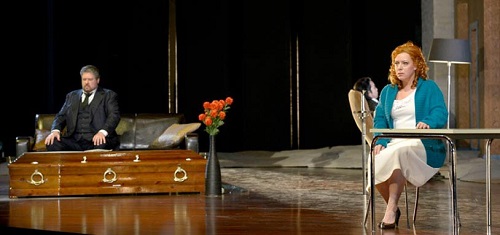 Germany Wagner: Tristan und Isolde, Deutsche Oper Berlin Orchestra and Chorus, Donald Runnicles (conductor), Deutsche Oper Berlin, 18.6.2016 (JMI)
Germany Wagner: Tristan und Isolde, Deutsche Oper Berlin Orchestra and Chorus, Donald Runnicles (conductor), Deutsche Oper Berlin, 18.6.2016 (JMI)

Production: Deutsche Oper Berlin
Direction: Graham Vick
Sets and Costumes: Paul Brown
Lighting: Wolfgang Göbbel
Cast:
Tristan: Stephen Gould
Isolde: Nina Stemme
King Marke: Matti Salminen
Brangäne: Tanja Ariane Baumgartner
Kurwenal: Ryan McKinny
Melot: Jörg Schörner
Shepherd: Peter Maus
Helmsman: Seth Carico
Young Sailor: Attilio Glasser
This Tristan und Isolde with its truly stellar cast was one of the main points of interest during my trip to Berlin. The vocal part of the performance met my highest expectations, but the music and the staging were less satisfactory.
It’s a revival of Graham Vick’s production, which premiered here five years ago and was greeted at the time with a storm of boos. The sets are basically the same throughout: a large space divided by a wall with a big window in the middle, rooms on both sides, and a coffin. In each of the acts, only the layout changes. There are people wandering about on the other side of the wall, but they have nothing to do with the action. The costumes bring the setting up to modern times.
There are stage productions that make one ponder, but it’s more desirable to think about them after the performance ends. If what is offered on stage is incomprehensible, there’s a real risk that the audience’s attention will be diverted from the music, and that’s the worst situation that a director can create. Graham Vick created a production that appears to be full of symbols, and one has to wonder what they could possibly mean. I cannot find any answers.
In Act I Tristan remains on stage, but so does King Marke, seated in an armchair; he rises at the end of the act to receive the Irish princess. Why is the coffin always on stage? What does the child making paper boats mean? How about the young woman wearing a veil and carrying a suitcase, who is hiding behind Tristan’s sofa? Who is the black widow laying flowers in the coffin? What does it add to the story that Tristan and Isolde inject the love potion rather than drinking it? What is the meaning of the young man digging a pit in Act II? Why is there a naked young woman wandering around the room, and what is she doing leaning against the doorway during the last half hour of the second act? I have always understood that Isolde, clasping Tristan’s body, dies of love. Not here: she simply goes off stage.
I first saw this production three years ago, and Donald Runnicles was on the podium then as well. This time around, his most inspired reading was in the second act, but the music was less convincing in Acts I and III. There was often an excess of sound, and he slowed down the tempos. The Deutsche Oper’s orchestra gave a much stronger performance than on the previous day in Die Entführung aus dem Serail.
There have never been many tenors capable of handling the part of Tristan, and today’s voices are no exception to the rule. American Stephen Gould is a powerful tenor, with an attractive voice that he pushed to the limit in the last act. To be able to overcome all the difficulties of this role makes him worthy of sincere admiration.
Swedish soprano Nina Stemme had the biggest triumph of the performance. She was a spectacular Isolde from beginning to end, and cannot be compared with her colleagues: she seems to be coming from another galaxy. The problem is that after having seen and heard her Isolde, the bar is set too high for future comparisons.
Veteran Matti Salminen was once again King Marke, and he gave a singing lesson in the monologue of Act II. His voice retains a firmness and freshness unusual for his age, and he does a fine job communicating emotion. It’s now forty years since his debut in this theatre, and he was given a well-deserved tribute at the end.
There was also a fine performance from mezzo-soprano Tanja Ariane Baumgartner as Brangäne. She is an outstanding artist, and always brings interest and intensity to her roles. She is one of the best possible Brangänes today.
American baritone Ryan McKinny as Kurwenal replaced Iain Paterson. His voice is attractive and well-suited to the part, but at times he suffered from the excessive sound coming from the pit.
Jörg Schörner did nicely as Melot, and veteran Peter Maus was also good as the shepherd. Seth Carico was an excellent helmsman in the first act, and Attilio Glasser was a correct young sailor.
José M. Irurzun

Thank You for an insightful revue’
One can only feel sorry for the poor singers these days who have spent hours building their careers, only to have their work overshadowed made to appear ridiculous by directors’ conceits! As an opera goer for 60 years I despair for what appears onstage these days. Munich, Bayreuth, and Berlin opera houses and their directors have much to answer for…
KR